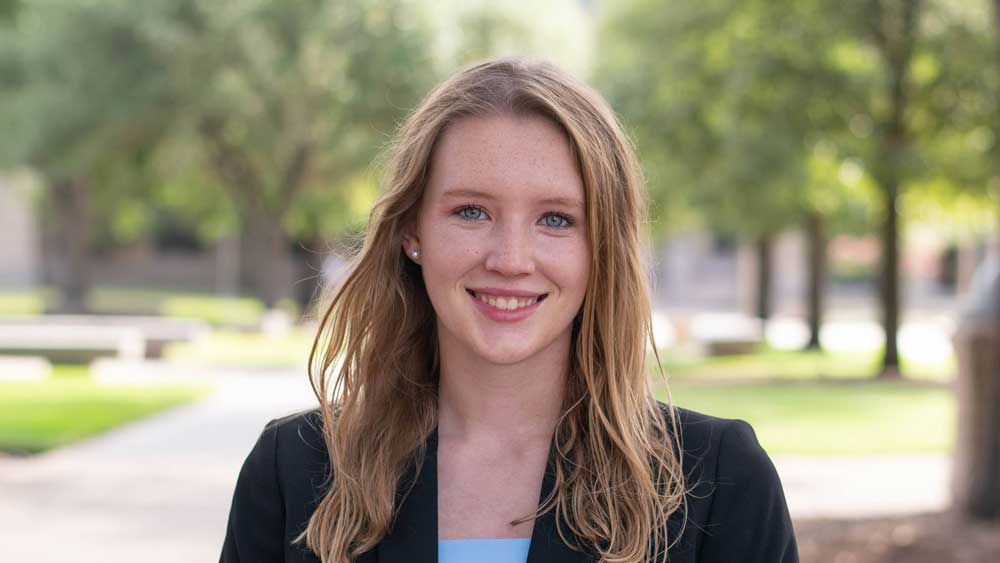
Growing up, Emily Payne enjoyed drawing and being creative. In high school, she took practicum-level fashion courses involving practical applications of fashion theory and excelled in her projects.
Trace the pattern. Measure. Check numbers. Cut and stitch. Fit the garment. Adjust and tweak. Review results. Those were the steps she carefully followed when creating a garment in high school. It seemed inevitable that Payne would become a designer until she found herself contemplating what seemed like a different world entirely — engineering.
Payne studied architectural engineering as an undergraduate student with an emphasis on mechanical systems and received a Bachelor of Science in Architectural Engineering from the Department of Multidisciplinary Engineering.
As a student with many interests, Payne was fascinated by architecture, math and critical thinking. "I felt that perhaps the world could use both my creative and mathematical sides," she said. "My grandpa was an engineer and always seemed kooky and creative, which also felt true for me."
Payne, who grew up in a military family and had seen her fair share of moves, was struck with the appeal of choosing her college experience. "It was nice to have Texas A&M be my choice," she said. "I liked the school's atmosphere and how friendly everyone was. I liked that the engineering departments here were highly ranked because I knew I would get a quality experience during my time in Aggieland."
With her choice of school and general area of study decided, Payne arrived at Texas A&M University, intent on majoring in biomedical engineering with distant dreams of attending medical school. However, a chance encounter with Dr. Morad Atif, the former director of the architectural engineering program, changed her mind.
"At the time, I didn't know Texas A&M offered architectural engineering, but I liked the idea of fabrication," said Payne. "I met Dr. Atif when I applied to the Entry to a Major process, and he told me, 'Oh, you like creativity. You should join architectural engineering.' After further considering it, the degree appealed to me since buildings have many different applications and purposes."
As an architectural engineering major, she took classes in architecture history, building energy analysis, structural analysis, thermodynamics, fluid mechanics and heat transfer. One of her courses focused on Revit, a building information modeling software used in construction and building engineering projects.
Payne completed several internships, including a mechanical engineering one at DRB Engineering, a fire protection engineering internship and an electrical engineering co-op at Jacobs Engineering. As an intern, she was exposed to more detailed projects due to her previous experience with Revit and mechanical courses, and used software to calculate heat loads in buildings.
As an undergraduate researcher at the Texas A&M Energy Institute, she analyzed bio-inspired complex network design and created opportunities for sustainability and resilience in building design, building construction and green technologies.
"Engineering, to me, means designing something for the use of others that makes people's lives easier — to make things."
Many people consider the arts a more tactile type of creativity and science more of an abstract, left-brain activity. Despite the perceived differences, Payne posits there are several similarities between fashion and engineering.
"Accuracy and taking your time are crucial. It's tempting to rush through completing homework and the learning process. But in fashion design, patience is essential," said Payne. "Mistakes often happen, and it feels like you've wasted the pattern and materials. But those are important lessons because you learn to examine where your errors occurred. You learn how to build your thought process."
In addition to engineering and fashion, Payne is a swimming enthusiast. She began swimming in high school and has been a Texas A&M swim team member for the last four years and continues to regularly compete in meets with her teammates for enjoyment.
On professional growth and graduate school
Despite several job offers prior to graduation, Payne found herself drawn back to academia and the creativity it offered. She is currently a doctoral student and graduate teaching assistant in the J. Mike Walker '66 Department of Mechanical Engineering at Texas A&M and shares that architectural engineering prepared her well for graduate coursework’s rigorous demands."My undergraduate education helped me to trust my judgment and make choices that positively impact what I want," she said. "Being surrounded by encouraging peers and professors heightened my awareness that there are people out there who want to support and help you, but sometimes you must work a little to find them."
Payne is researching systems engineering and analysis using biology-inspired designs on microgrids, power grids and building-human interaction networks.
"For me, a Ph.D. is about using your creativity to think about problems that no one has thought about yet or random ideas that can turn into papers," she said. "It's about exploring things that interest you and making creative and different things."
"I often wonder, 'Who came up with this?' But when you read a research paper, researchers break it down into understandable steps as to why they did this or that and why they thought it was important. They discuss how they tried to solve this problem. If it worked, if it didn't work — but they use complicated language to do it."